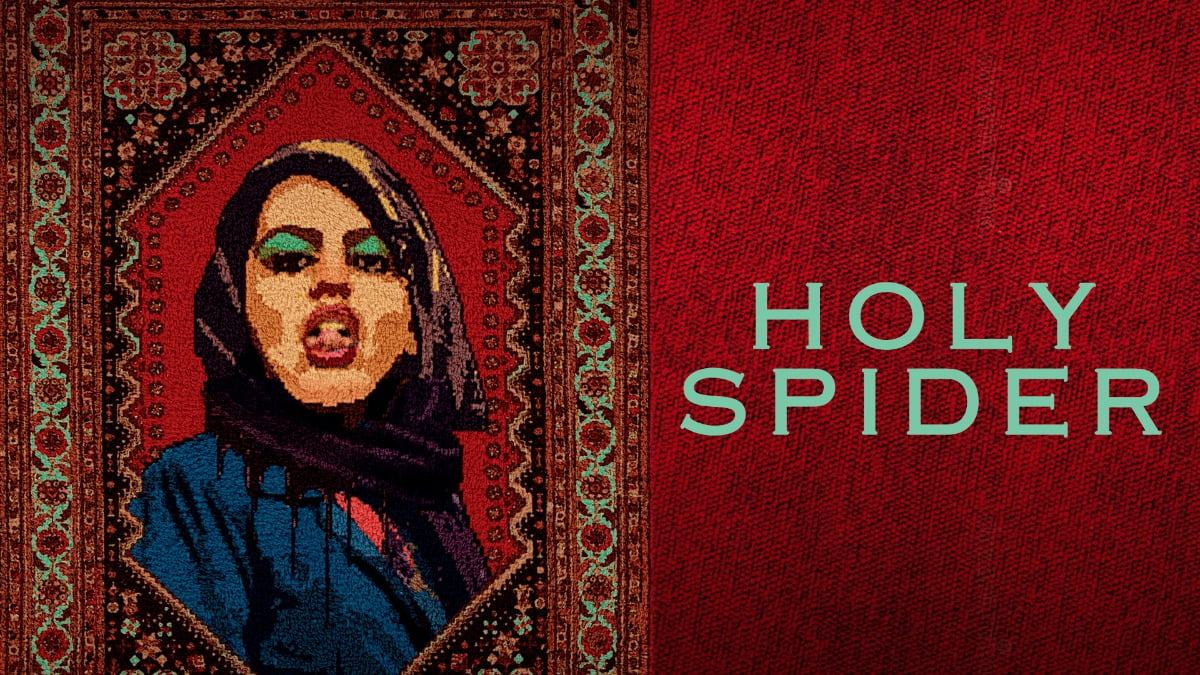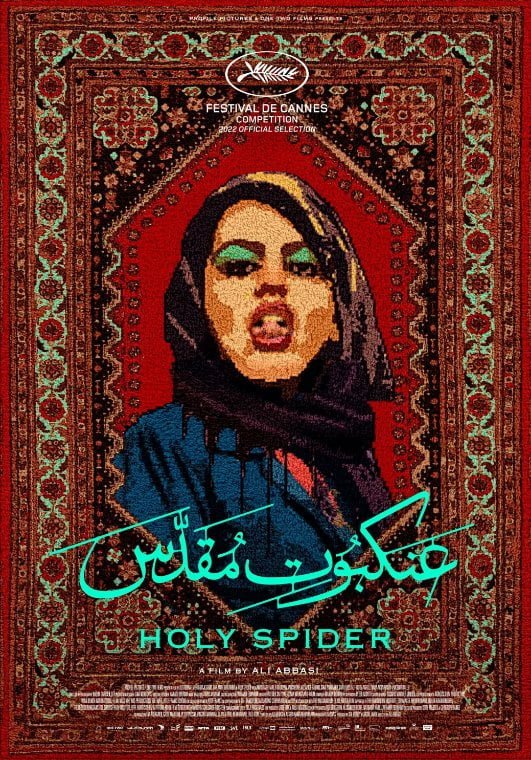In the dimly lit corridors of crime and justice, where shadows dance with secrets, Holy Spider emerges as a distinctive serial killer procedural that boldly ventures beyond the well-trodden paths of the genre. Directed and co-written by the visionary Ali Abbasi, renowned for his surreal body-horror satire Border (2018), this film beckons audiences into the unsettling world of Saeed Hanaei, the infamous ‘Spider Killer’. While it masquerades as a true-crime drama-thriller, Holy Spider artfully interlaces elements of horror, suspense, and socio-political commentary, creating a narrative tapestry that both intrigues and challenges.
While it masquerades as a true-crime drama-thriller, Holy Spider artfully interlaces elements of horror, suspense, and socio-political commentary, creating a narrative tapestry that both intrigues and challenges.
In this fictionalised true-crime drama-thriller, Abbasi doesn’t stop at the standard denouement and arrest scenes. Instead, he unfolds the murderer’s theatrics across the police cell, law courts, and media arena, creating a narrative that goes beyond the ordinary.
Post-colonial reflections in the irony of a holy city
The film’s central irony lies in Mashhad, a holy city fostering prostitution and emboldening a killer on a purported mission to cleanse it. Abbasi raises thought-provoking questions about the contradictions within society’s moral fabric, using Hanaei’s story as a lens to examine deeper sociopolitical issues.
Holy Spider emerges as a narrative interwoven with the socio-political undercurrents of Iranian society. By examining Saeed Hanaei’s murderous spree, the film prompts viewers to question the societal structures and religious fervour that may inadvertently foster such gruesome acts. Abbasi’s exploration of post-colonial dynamics adds complexity, challenging audiences to reconsider their perceptions of heroism and villainy.
The patriarchal puzzle: layers of oppression in Rahimi’s pursuit
As Rahimi navigates the labyrinthine plot, she allies with a dishevelled local reporter (Arash Ashtiani), a character crafted with nuance and purpose. Together, this odd couple confronts the sneering, sexist police chief Rostami (Sina Parvaneh), portraying a system that willfully misreads the dynamics of #MeToo situations and perpetuates a culture of harassment. The film masterfully exposes the interconnected layers of oppression, intertwining the socio-political fabric with the suspenseful narrative.
At the heart of the story is Rahimi, a fictional investigative journalist from Tehran, challenging the patriarchal mindset embedded in the police force and the judiciary. The film suggests that the killer’s elusiveness is perpetuated by a system where the cops, judiciary, and culprit share the same patriarchal ideology. Rahimi becomes a symbol of resistance, attempting to crack the case while navigating a world where sexism and misogyny prevail.
The trauma of an unholy mission: the origins of the spider killer
To comprehend the enigmatic figure of Saeed Hanaei, the audience is thrust into the tumultuous life of Mehdi Bajestani’s portrayal. A war veteran haunted by his perceived lack of heroism during the Iran-Iraq conflict of the 1980s, Hanaei metamorphoses into an angry and conflicted building site worker. The film unearths his self-loathing, painting a vivid picture of a man torn between societal expectations and personal demons.
A war veteran haunted by his perceived lack of heroism during the Iran-Iraq conflict of the 1980s, Hanaei metamorphoses into an angry and conflicted building site worker.
This character exploration serves as the pulsating heartbeat beneath the film’s exterior, lending depth to the seemingly one-dimensional veneer of a serial killer. Saeed Hanaei, portrayed as an angry and conflicted war veteran, reflects the traumas of the Iran-Iraq war. The film subtly delves into trauma theory, exploring how Hanaei’s past experiences contribute to his descent into violence. This approach humanises the killer, prompting viewers to grapple with the impact of war on individuals and society.
Critique of genre-film stylings in Rahimi’s singular representation
While Holy Spider attempts to unravel complex sociopolitical questions, it occasionally succumbs to genre-film stylings. The film’s psychosexual spectacles sometimes overshadow the broader societal issues it aims to address. Abbasi’s fascination with the contradictions in Hanaei’s character risks oversimplifying the film’s exploration of misogyny and societal hypocrisies.
One notable critique lies in the film’s singular focus on Rahimi as the sole representative of women’s concerns. Despite the brief glimpses into the lives of Mashhad’s prostitutes, their stories remain overshadowed by gratuitously detailed killings. A missed opportunity arises as the film fails to delve into the courageous real-life story of a woman who fought back against Hanaei, portraying a more nuanced perspective on women’s experiences.
A dance of shadows: Rahimi’s quest for justice
Breaking away from the conventional mould, Holy Spider introduces Rahimi (Zar Amir-Ebrahimi), a fictional investigative journalist from Tehran. Rahimi descends upon Mashhad with a fervent desire to unravel the intricacies of the Spider Killer case.
Rahimi descends upon Mashhad with a fervent desire to unravel the intricacies of the Spider Killer case.
However, the film takes an unexpected turn by positioning Rahimi not merely as an observer but as a crucial player in the unfolding drama. This departure injects a refreshing dynamic into the storyline, emphasising the complicity of the police, the judiciary, and the killer himself within the overarching patriarchal mindset.
Baiting the beast: Rahimi’s confrontation
In a time-honoured and slightly preposterous narrative device, the film propels Rahimi into the heart of danger. The question looms: how does Rahimi confront a psychotic assailant deeply ingrained in violence? Here, the film treads the fine line between suspense and implausibility.
Rahimi, lacking martial arts training and armed only with a knife, becomes the bait in a high-stakes gamble to expose the Spider Killer’s true nature. This climactic juncture captivates audiences, offering a glimpse into the intricate game of cat-and-mouse that defines the thriller genre.
Genre-driven thrills vs sociopolitical commentary
Beyond the individual characters and their harrowing experiences, Holy Spider serves as a mirror reflecting societal contradictions. Mashhad, depicted as a spiritual hub for Shiite Muslims, becomes the backdrop for a riveting exploration of how ostensibly holy cities can harbour the darkest secrets. The film boldly confronts the paradoxes within a theocratic state, shedding light on the harsh realities of prostitution, the drug trade, and the Spider Killer’s ruthless acts.
In navigating the murky waters of genre-driven thrills and socio-political commentary, Holy Spider finds a delicate equilibrium. The portrayal of Hanaei as a complex amalgamation — an upstanding Muslim, a family man, a pervert, and a ruthless killer — raises poignant questions about the multifaceted nature of humanity. However, the film falls short in providing a comprehensive exploration of the lives of Mashhad’s prostitutes, reducing them to fleeting glimpses before their gratuitously detailed killings.
Missed opportunities: untold stories and unexplored realities
Despite the film’s attempt to address women’s concerns through Rahimi’s character, portrayed with conviction by Zar Amir Ebrahimi, it leaves the audience yearning for a more nuanced exploration of the lives of Mashhad’s prostitutes. The untold stories of courage, such as the woman who fought back and reported Hanaei to the police, remain on the periphery, overshadowed by the film’s focus on the killer’s life. In this regard, Holy Spider misses the opportunity to delve deeper into the untold narratives that deserve recognition.
Holy Spider‘s dark quilt unraveled
In the labyrinthine narrative crafted by Ali Abbasi, Holy Spider unfolds as a dark loomwork woven with threads of justice, societal hypocrisy, and the haunting legacy of a serial killer. As viewers navigate the intricate plot, they are treated to intense performances, a killer-centric script, and moments of genuine suspense.
However, the film leaves them yearning for a more profound exploration of the untold stories lurking in the shadows — stories that could have elevated Holy Spider from a gripping thriller to a cinematic masterpiece. In its current form, Holy Spider stands as a bold foray into the intersection of crime, morality, and societal complicity, challenging audiences to confront uncomfortable truths dwelling within the human psyche.
About the author(s)
Harshi is a writer and LGBTQ+ rights activist. She is also a self-identified singer. Her preferred pronouns are she/they and she identifies as a Non Binary Transwomxn. Raised to be someone who should just accept the norm , she has spent the last decade reading and writing about eccentric people and their experiences around her. Harshi has completed B.A.(HONS.) English from the University of Delhi and M.A. in English from Amity University. She cautions anyone who is thinking of doing the same. She thinks she is a realist, she still hopes to see some good change in the history of Human Rights in her country with a little contribution from her writing and activism. You can find her on Instagram- iamharshib.









